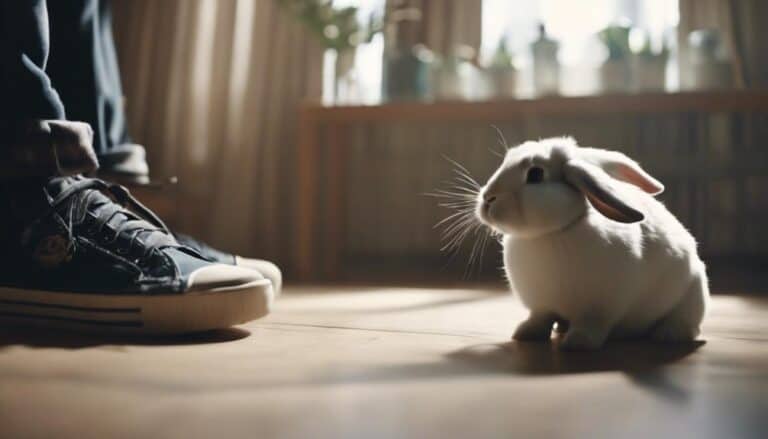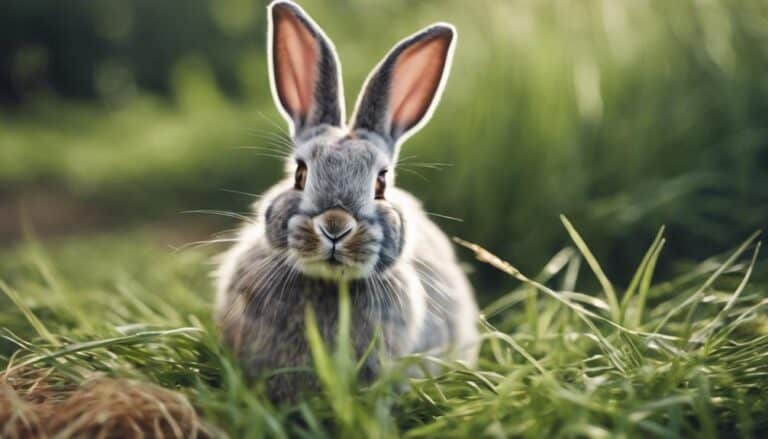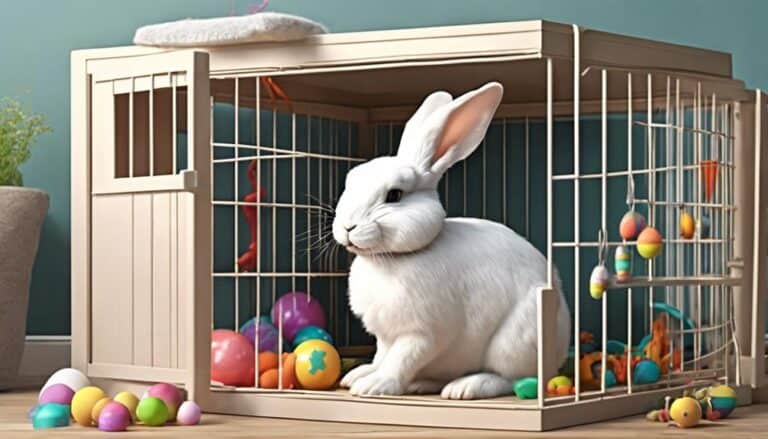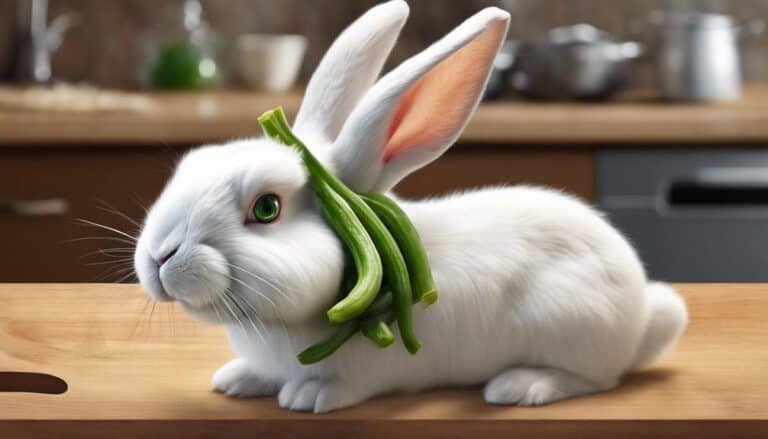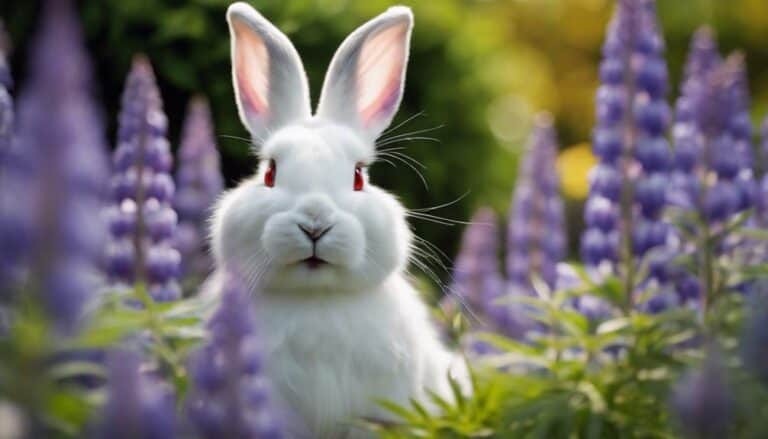So, have you ever stopped to think if your pet rabbit is more attached to you than to other bunnies?
It turns out that the bond between a rabbit and its owner goes way beyond just hanging out together.
If you pay attention to your rabbit's behavior and how they interact with you, you'll start to notice little signs that suggest they really care about you.
But what makes the relationship between a pet rabbit and its owner so different from the relationships between rabbits in the wild or in a group setting?
Contents
Key Takeaways
So, do pet rabbits love their owners more than other bunnies? Well, the answer is yes, and it's because of the strong bonds they form with their owners.
You see, consistent care and positive interactions with their owners help pet rabbits develop strong bonds. When they're socialized early on and spend quality time with their owners, it fosters deeper affection. But here's the thing: each rabbit has its own personality, and their experiences also play a role in how they express love towards their owners.
Building trust and companionship is key. When owners understand and meet the needs of their pet rabbits, it strengthens their bond. And you know what's really cool? Rabbits show affection in unique ways, like grooming and following their owners around. These behaviors are their way of saying, "Hey, I love you too!"
Signs of Rabbit Affection
Rabbits show affection towards their owners in various ways. One significant sign is when they groom their owners. This can involve social grooming, licking, or nibbling, which is a big deal because it means they trust and love you. It's a strong bond between the two of you.
When your rabbit runs in circles around your feet, it's a sign they're happy and excited. You might see this during meal times or when you're greeting each other. It reinforces the idea that you have a strong connection.
Rabbits also show affection by seeking human interaction. They love being petted and might even nudge you or lower their head to show they're enjoying it. This is a clear sign they love and trust you.
Laying next to you is another way rabbits show trust and comfort. They're vulnerable in this position, so it means they feel safe around you. It's a profound bond between the two of you.
Factors Influencing Rabbit Attachment
Rabbits can form strong bonds with their owners, just like any other pets. But did you know that certain factors can influence how attached your rabbit becomes to you?
One key element is early socialization. Rabbits that are handled frequently and gently from a young age are more likely to form strong attachments to their owners.
Consistency is also crucial. Providing rabbits with a regular routine, such as feeding them at the same time each day, cleaning their living space regularly, and offering enrichment activities, can help strengthen the bond between rabbits and their owners.
Positive interactions are also vital. Spending quality time with your rabbit, such as petting, grooming, and playing with them, can enhance the level of attachment they feel towards you.
Understanding Rabbit Social Dynamics
Rabbits have their own way of forming bonds, and it's influenced by their unique personalities and life experiences. This, in turn, affects how they interact with humans.
To build a strong and positive relationship with your rabbit, it's crucial to understand their social dynamics. By doing so, you'll be able to recognize the cues and behaviors that show you how they're feeling and what they prefer.
Once you're able to observe and comprehend these dynamics, you can strengthen your bond with your pet rabbit and create a truly fulfilling companionship.
Rabbit Bonding Behavior
Understanding rabbit social dynamics is all about observing how these small mammals interact with each other in a group setting. As prey animals, rabbits rely heavily on social bonds to feel secure and safe in their environment.
When it comes to bonding behavior, one key thing to look out for is grooming. Rabbits show affection and strengthen their bond by grooming each other. This behavior helps build trust and companionship among group members. It's a way for them to say, 'Hey, I've got your back."
Another important behavior is huddling. When rabbits snuggle up together, it's a sign that they feel safe and comfortable around each other. This behavior is a clear indication of the bond and trust they've established over time. They're saying, 'I feel safe with you."
You'll also notice playful interactions, like hopping around, chasing each other, or playing with toys. These activities demonstrate a strong bond and sense of camaraderie among rabbits. They're having fun together and strengthening their social connections in the process.
Human-Animal Relationship
So, let's take a closer look at the special bond between humans and rabbits. It's pretty amazing to see how they form a connection based on mutual understanding and interaction. Rabbits really do love and trust their owners deeply, and they show it in various ways.
For instance, when your pet rabbit comes running over to greet you or nudge your hand for pets, it's clear they love having you around.
Spending quality time with your rabbit is key to strengthening your bond. Activities like petting, grooming, or playing together really bring you closer. Rabbits get super excited to see their owners, and they show it by behaving in joyful ways – like binkying, which is basically a happy jump that says they're thrilled to see you.
This connection between humans and rabbits goes way beyond just having a pet. It's an emotional connection where both you and your rabbit get comfort and joy from each other's company.
To make this relationship really strong and loving, you need to understand and respect your rabbit's needs and behaviors. That way, you can build a bond based on trust and mutual affection.
Behavioral Differences in Pet Rabbits
Pet rabbits behave differently compared to their wild counterparts when living in domestic settings. One major difference is that they're super social and love to show affection to their human caregivers.
For instance, pet rabbits tend to seek out human interaction. They really enjoy being petted, groomed, and cuddled, which is a clear sign that they’re attached to their owners. This is quite different from wild rabbits, who are generally more focused on survival. Moreover, pet rabbits often display unique personalities and can become quite sociable, forming bonds not only with humans but also with other pets in the household. In contrast, when it comes to caring for rabbits versus pet mice, the differences become evident in their habitats and social needs, as rabbits require more space and social interaction while mice thrive in smaller, enclosed areas. Understanding these differences is essential for ensuring that both types of pets lead happy and healthy lives.
Another difference is that pet rabbits are less fearful. Since they're raised in a safe environment, they don't have to be constantly on the lookout for predators like wild rabbits do. As a result, they're more relaxed around humans.
You might also notice that pet rabbits are more vocal than their wild counterparts. They use various sounds to communicate with their owners and express their needs or emotions. This increased vocalization is likely due to the fact that they've been bred for companionship rather than for meat, which has strengthened the bond between pet rabbits and their owners.
Impact of Human-Owner Bonding
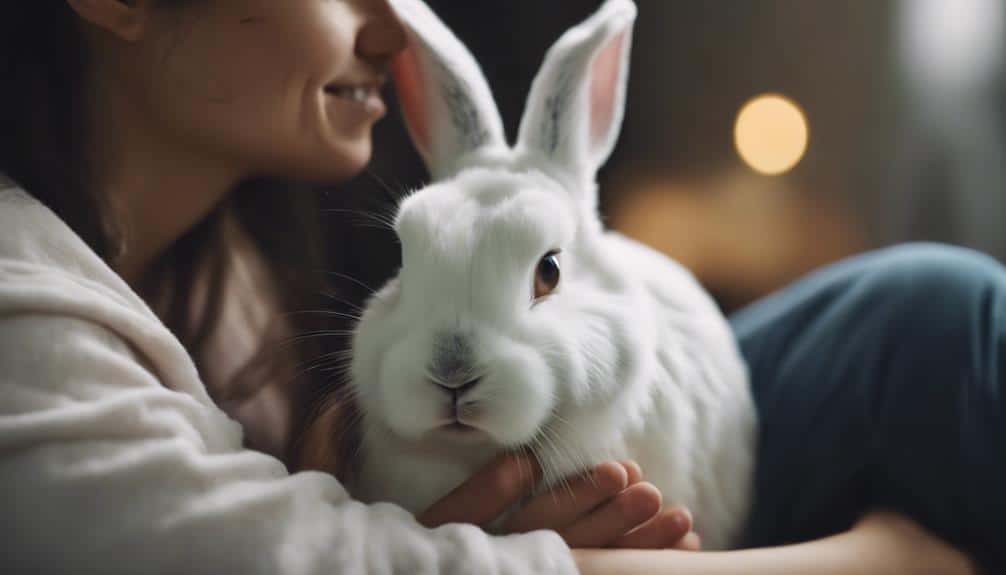
The bond between pet rabbits and their owners can have a big impact on the rabbits' behavior and social interactions. For example, rabbits that are close to their owners often show affectionate behaviors like grooming, licking, and nuzzling. In some cases, this bond can even make rabbits prioritize attention from their owners over bonding with other rabbits.
It's also worth noting that every rabbit is different when it comes to showing affection. Some are naturally more affectionate than others, and this can affect how they behave around their owners.
Interestingly, rabbits can pick up social cues from their owners, too. If an outgoing rabbit is around a shy one, it can actually help the shy rabbit become more trusting and bold. But even if a rabbit has a bonded mate, it doesn't mean it will be less affectionate towards its human caregiver.
In fact, understanding how the human-owner bond affects rabbits can help owners build stronger relationships with their pets.
Promoting Rabbit-Human Relationships
So you want to build a strong bond with your pet rabbit? Well, the first step is to understand rabbit bonding behaviors.
When you take the time to build trust with your bunny through gentle interactions and positive reinforcement, you can create a strong and loving relationship.
Paying attention to communication cues like body language and vocalizations is also super important.
Rabbit Bonding Behaviors
When you're trying to build a strong connection with your pet rabbit, it's really important to understand how they show affection and build trust. Rabbits have their own ways of expressing emotions and building bonds with their owners.
They can be super affectionate, and they show it in different ways. For example, they might lick you, nuzzle you, or even follow you around. Sometimes they'll even run up to greet you at the door! This is their way of saying they're attached to you and appreciate the bond you share.
Rabbits also need to feel safe and secure, and they find comfort in their owner's presence. When you hold them, cuddle them, or hand-feed them treats, they feel protected and cared for. This helps them trust you even more.
As social animals, rabbits need interaction with their owners. They can tell the difference between people and respond to their owner's emotions. This helps deepen the bond between you and your rabbit.
Building Trust With Rabbits
Building trust with your rabbit is crucial for a strong, loving bond. It takes time and gentle interactions to get there.
Physical contact, like cuddles and pets, can really help. But it's essential to approach your rabbit with respect and let them set the pace for touch. If they're comfortable with you, they might let you pick them up or cuddle them, which means they feel secure around you.
When you're with your rabbit, always ask permission before petting them. Some rabbits need time to get used to being touched, and forcing it can make them uncomfortable.
If you show them affection and respect their boundaries, you can build trust and deepen your bond. Remember, trust is a two-way street. By being patient and understanding, you can create a loving relationship with your pet bunny that will last.
Communication Cues With Bunnies
Rabbits establish relationships with humans through various communication cues, and they mainly rely on body language to convey trust and affection.
Understanding these cues can really help strengthen the bond between you and your rabbit. So, how do they communicate with humans?
One way is through binkying, which is a joyful and playful behavior that indicates your rabbit is happy and feels safe in your presence.
Physical contact is another way. Cuddles and pets can create a sense of security and intimacy, fostering a deeper connection between you and your bunny.
Lastly, recognizing affection is key. By being attuned to subtle signs like nuzzling or licking, you can recognize when your rabbit is showing affection towards you.
Conclusion
The bond between pet rabbits and their owners is super strong, built on trust, care, and affection.
That's clear. But, do they love their owners more than other bunnies? That's still a tough question to answer.
We need more research and observation to really get the intricacies of rabbit behavior and relationships.

